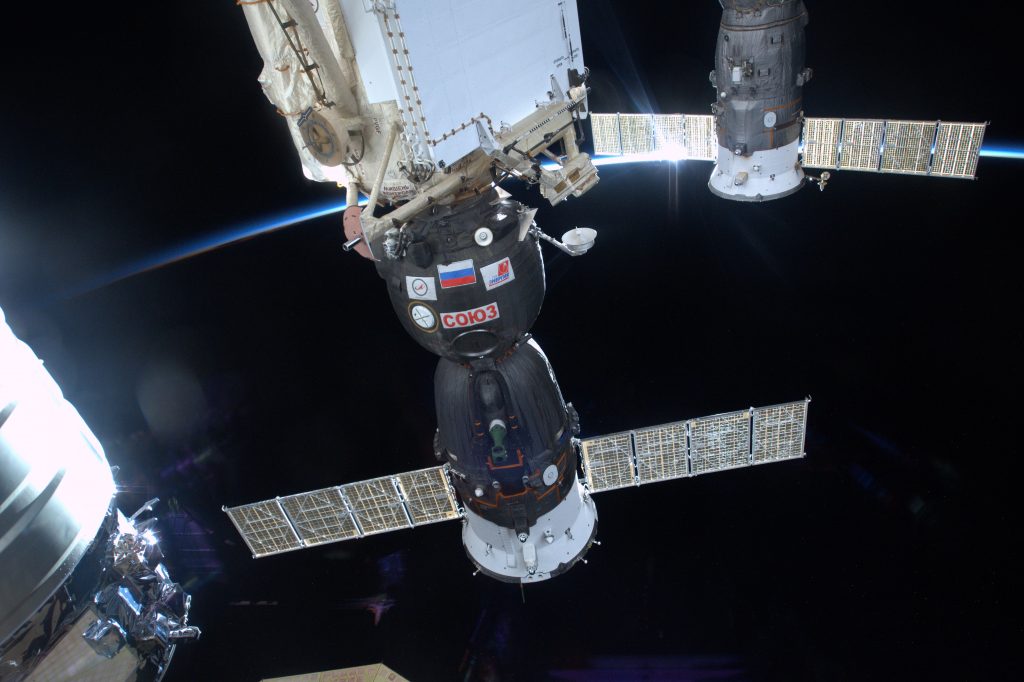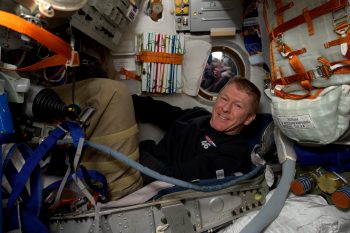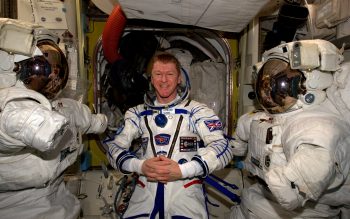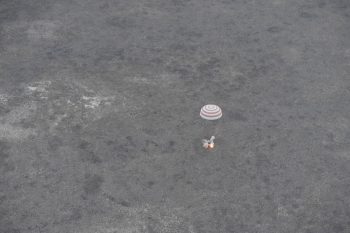
Tim Peake’s first photo from space: the Soyuz TMA-19M that took him to the Space Station and will bring him home. Credits: ESA/NASA
ESA astronaut Tim Peake’s time on the International Space Station has come to an end. The Soyuz TMA-19M is packed with equipment and Yuri Malenchenko, Tim Kopra and Tim are set for departure to return to Earth. At 02:35 GMT they will close the hatch between their Soyuz spacecraft and the Space Station and start preparations for the return flight.
This video explains the Soyuz undocking and landing.
First the astronauts will remove the clamps inside the docking assembly and close the hatch between the International Space Station and Soyuz. They will perform a leak check of the docking interface by reducing the pressure in the vestibule between the two hatches.
The astronauts will “salt-load” to fill their bodies with water to counteract the fact that in space your body holds less water. If they did not fill up with water they risk arriving on Earth seriously dehydrated.
As they wait for pressure checks to complete in their capsule they will read instructions Moscow Mission Control radioed to the astronauts with advice for landing:
“The following sensations can be expected in response to g-loads during reentry:
- Sensation of g-load pressure on the body
- Heaviness of the body
- Labored breathing and speech.
These are normal sensations. Take them calmly. Should you experience any visual disturbances: immediately create additional tension of leg and abdominal muscle (pull your stomach in). You must use a breathing exercise: Take a big deep breath, hold it for as long as you can , then exhale.”
Yuri and the Tims will put on medical telemetry belts and tight-fitting shorts called the Kentavr to stop blood from the legs flowing to the head during reentry. Afterwards they will put on their Sokol pressure suits in the orbital module.
The orbital module will burn up in the atmosphere in just a few hours so the next step is to close the hatch inside the Soyuz spacecraft between the descent and orbital module.
They will test their Sokol suits for leaks and once complete decrease the pressure by 150 mm mg in the orbital module to verify that the hatch between the two modules is airtight.
The undocking will release springs that push the two spacecraft away from each other, at 20 meters distance the Soyuz will fire its engines to increase the departure velocity. They will spend about two hours orbiting Earth before braking to reenter our planet’s atmosphere at around midnight.
From here it will go quickly, three modules of the spacecraft will separate with two burning up in the atmosphere. The descent module will encounter tem
peratures of up to 1600°C as friction from the atmosphere heats the protective shield and blocks all radio communication.
At 10 km above sea level a parachute is deployed automatically, slowing the astronauts down from 864 km/h to 324 km/h. The base heatshield is then jettisoned to expose the four solid-propellant motors.
Retro-rockets fire moments before impact to bring the touchdown forces to a minimum – still likened to the force of a small car crash. The Soyuz seats are custom-fit and include springs to soften impact even more.
Search and rescue teams will be on hand as soon as possible.
Here is a brief timeline of the undocking and reentry, all times in GMT:
| 05:51 | Undocking command |
| 05:52 | Separation |
| 05:55 | Thruster firing |
| 08:22 | Large deorbit burn for four minutes |
| 08:49 | Module separation 139 km above Earth |
| 09:00 | Parachute opens 10 km above Earth |
| 09:14 | Retrorockets fire an instant before touchdown |
Moscow Mission Control ends its standard radiogram with this advice after landing:
“ After landing:
Do not rise from your seat or leave the Descent Module too soon. Stay in your seat for several minutes and only then rise from the seat!
Limit head and eye movement.
…
Take it easy. We look forward to seeing you on the ground.
Have a safe landing and return to Earth!
End of Radiogram “




Discussion: 8 comments
Ooh im so excited cant wait to watch live just love these events good luck guys
Hope all goes well on Saturday for the return home Tim. Congratulations on an inspirational 6 months – it’s been great seeing your photos and getting the updates on your work. Have a great reunion with your family and hope you soon adjust to being home. Look forward to hearing what your next challenge will be.
Congratulations on your space journey and good luck
It has been a privilege to be so involved as I remember the first NASA spaceflight and it just seemed so detached. How far we have come?
Good luck you guys
Earth sends it’s respect to you
Will be watching you return
I can’t wait to watch. Goodluck.
I cycled to Chichester Cathedral a few weeks ago, and Chichester says it missed you and to come home safely.
Don’t forget to bring a Kazakh phrasebook in case you need to order some brunch while you wait.
Wishing you a safe return to Earth Tim. It has been wonderful to follow your work these last six months on the ISS. You have inspired the children I teach and a whole generation of young minds to dream big. So glad you will be home for Father’s Day. Wishing you a wonderful reunion with your family and friends.
Tim, Tim and Yuri, I hope you arrive home safely. You have all been such an inspiration to all generations and it has been such a pleasure to see our beautiful Earth from your perspective.. You have given us the opportunity to see parts of the Earth that many of us would not be able to visit. The photographs have been stunning! Thank you all especially all of the background crew who made it all possible .
nonton sex
http://178.128.252.218/?id=bokep+gratis